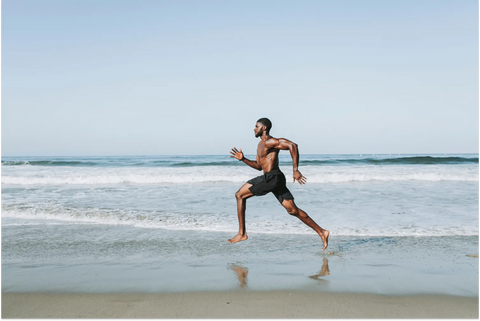The sound of waves crashing, the smell of saltwater in the air, and the feeling of sand underfoot: for many, the beach is not just a place to unwind but also an inviting terrain for a different kind of workout — beach running.
Running alongside a large body of water is nothing new, but it has gained considerable attention in recent years, making it more than just a summer fad.
One of the most frequently asked questions about this trending activity is its effect on joint health. Does the soft nature of sand provide a cushion against the jarring impact running usually has on the joints? Let's dig in.
What Is Beach Running?
Beach running is the practice of running on a sandy shoreline, typically adjacent to an ocean, sea, or large lake. While the definition seems simple enough, the nuances of this activity make it far from straightforward. The experience can vary significantly based on various factors like sand quality, tide level, and your chosen footwear.
Historical Context and Mainstream Popularity
The origins of beach running can be traced back to elite athletes and coaches who discovered the added resistance of sand as a powerful tool for strength and conditioning. It was often used as both a high-intensity interval training (HIIT) method and for rehabilitating sports-related injuries. The beauty and calming effects of the beach were just bonuses.
Fast forward to today, and beach running has transformed into a mainstream fitness trend. It's not just for the seasoned athlete anymore — fitness enthusiasts of all levels are embracing this form of exercise, often incorporating it into holiday plans as a way to stay active while enjoying a serene landscape. Companies even organize beach running events, making it a community experience that extends beyond the individual.
Variations and Considerations
Beach running is not a one-size-fits-all activity, and the kind of experience you have can be drastically different depending on your choices. Footwear is a crucial factor; some prefer the naturalistic approach of running barefoot to feel the sand between their toes, while others opt for specialized shoes that offer protection against sharp shells or rocks.
Moreover, the type of sand you choose to run on also has implications for your workout. Wet sand near the water’s edge offers more stability but less resistance, making it a good starting point for beginners. On the other hand, the dry, loose sand further inland provides a more challenging workout due to increased resistance but may also be tougher on your calves and require better balance.
What Are the Benefits of Beach Running?

There are a few reasons why you’ll often see many people running down the shoreline and exercising. Here are just a few examples of the benefits of beach running:
Burn More Calories
Beach running is nothing short of a full-on caloric assault; it's an exercise powerhouse when it comes to burning fat. Studies indicate that you can burn up to 1.6 times more calories while running on sand as compared to harder surfaces like asphalt. This tremendous calorie-burning effect is largely attributable to the sandy terrain.
The loose, shifting nature of sand creates natural resistance that requires your muscles to exert extra effort. Every step you take is like a mini leg-lift, as the sand gives way beneath you, necessitating more energy to push off and move forward — and that energy expenditure translates directly to calories burned.
So, if you're looking to rev up your weight loss or fitness regimen, trading the treadmill or sidewalk for the beach could be your secret weapon.
Build Stronger Muscles
Running on sand is like a resistance training session, particularly targeting your lower body. Your quadriceps, hamstrings, and calves are called into high-gear action to navigate through the soft and shifting sandy surface.
The instability of the sand puts your leg muscles to work in ways that a flat, hard surface simply can't replicate. This, in turn, translates into a workout that can build stronger, more resilient muscles in a shorter amount of time.
The benefits don't stop at your legs, though. Your core muscles, which include your abs, lower back, and obliques, are also engaged more intensively. This is because the unstable terrain demands that you constantly stabilize your body to maintain balance, thereby strengthening your core. The resulting improvement in posture and balance is an added bonus, making beach running a holistic muscle-building exercise.
Holistic Wellness
Running on a beach isn't merely a physical endeavor; it's a holistic experience that encompasses both body and mind. The surrounding ocean, the rhythmic lapping of waves, and the salty air combine to create a natural, serene environment that can help with stress management.
Several studies have shown that just spending time near water can increase feelings of well-being and relaxation. Moreover, the increased levels of vitamin D you get from sun exposure (while wearing sunscreen, of course) can help improve your mood and overall mental health.
As such, beach running can be a natural antidote to the stresses of modern life, providing a powerful, double-pronged approach to wellness — boosting both physical fitness and mental well-being.
How Does Beach Running Impact Joints?
Beach running is an activity rich in benefits, and perhaps the most compelling one is its positive impact on joint health. The soft texture of the sand acts like a natural cushion for each step you take, absorbing much of the shock that would otherwise travel up your legs and into your joints when running on a hard surface.
This cushioning and shock-absorbing properties effect is corroborated by multiple scientific studies, which suggest that running on softer surfaces like sand can significantly mitigate impact forces on the joints. As a result, it might reduce the risk of common running injuries like runner's knee, shin splints, and stress fractures.
However, it's essential to note that the same softness and instability of sand that provide the cushioning effect also require a different type of muscle engagement. The shifting terrain can cause your muscles to fatigue more quickly, which is why experts often recommend that new beach runners gradually introduce sand running into their training programs.
Additionally, the sand’s unstable surface can result in an increased risk of ankle sprains, especially for people with existing joint issues. A gradual integration allows the body's musculoskeletal system to adapt to the unique demands of this type of exercise, reducing the risks of injury and ensuring a balanced approach to joint health.
How Can Plant-Based Nutrition Support Joint Health for Runners?

Nutrition is a crucial but often overlooked cornerstone of joint health, especially for runners who put considerable strain on their joints. While many people turn to fish-based omega-3 fatty acids to alleviate joint pain, plant-based options like those derived from algae offer an effective, sustainable, and cruelty-free alternative.
Algae-based omega-3s, rich in DHA and EPA, have been shown to help reduce tension in the body. Tension is often the root cause of joint discomfort and stiffness, so reducing it can significantly improve joint flexibility and overall comfort.
Furthermore, plant-based diets are generally high in antioxidants, which can help support cell health during exposure to oxidative stress. This is another factor that can contribute to joint tension, tenderness, and subsequent discomfort.
By adopting a plant-based diet rich in omega-3s and antioxidants, runners may not only improve their joint health but also accelerate recovery and enhance performance. This makes it an all-around winning strategy for anyone who loves the feel of the sand beneath their feet as they run along the beach.
How Do iwi life's Products Complement a Beach Running Routine?
iwi life offers a range of plant-based omega-3 products specifically designed to support your joint health, making them an excellent addition to your beach running routine. Whether you're a seasoned beach runner or a beginner, running on sand demands more from your joints and muscles.
Incorporating iwi life's algae-derived omega-3 supplements can be a game-changer and may allow for a comfortable and extended running experience. In addition, these omega-3 fats help support your immune system, providing an overall wellness boost that aligns perfectly with the benefits of beach running.
Running on the beach can be a transcendent experience, connecting you to nature while providing a robust workout. iwi life's supplements aim to enhance this experience by ensuring that your joints are well-supported, allowing you to get the most out of this unique and effective form of exercise.
With reduced feelings of tension and support for joint mobility, you'll find yourself better equipped to enjoy the natural, joint-friendly benefits of running on sand, making every beach run a stride closer to perfect health.
The Bottom Line
So, is beach running joint-friendly? Generally speaking, yes. The softness of the sand can act as a natural cushion for your joints, potentially reducing the risk of running-related joint injuries. However, it's crucial to note that while the soft surface provides benefits, it also comes with its own set of challenges that require proper conditioning and preparation.
Plant-based nutrition, such as iwi life's range of algae-derived omega-3 products, can serve as a natural complement to your beach running routine by offering added joint support.
So why not give beach running a try? Feel the sand beneath your feet, listen to the waves, and soak up the benefits for your body and mind. And while you're at it, consider incorporating iwi life's plant-based omega-3 products into your wellness routine to give your joints the extra support they deserve.
Run responsibly, fuel naturally, and let's make every step count for a healthier, happier you.
Sources:
How to Run on the Beach, According to Running Coaches | Nike
Here’s Why You Shouldn’t Run Barefoot On the Beach | GQ
Calories Burned Running on the Beach | livestrong
Running On The Beach: Sand Running Benefits + 10 Helpful Tips | Marathon Handbook
Just Being Near Water Can Help Boost Mental Health — Even Virtually | Today
The Pros and Cons of Beach Running | Washington Post
An Anti-Inflammatory Diet May Be Good for Your Joints | Harvard Health
Antioxidant and Oxidative Stress: A Mutual Interplay in Age-Related Diseases | PMC



















